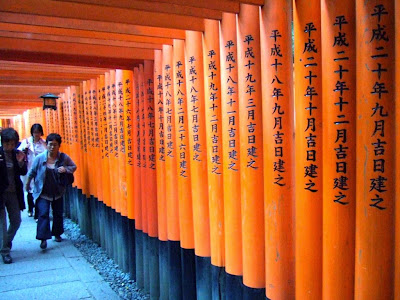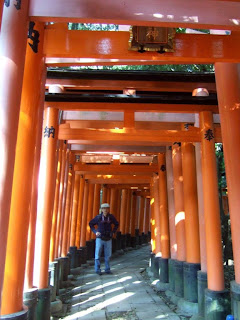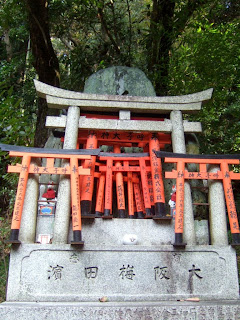
Inari which is supposedly a Goddess of Rice in the past gradually became an object of worship after it was dedicated in a shrine founded in year 711 at Inari Mountain. In early Heian period (794-1185) Imperial court was patronage to Inari Shrines and when the deity turned into a patron of blacksmiths and protector of warriors in 16th century, the worship spread all over Japan especially in Edo period (1603-1868). Inari Okami now in Japan is god of rice, agriculture, fertility, prosperity, worldly success and of course include wealth. Businessmen praying or paying homage to it for a better fortune is a common and tradition practice in Japan commercial market. There are more than 30,000 Inari Shrines across the country and Fushimi Inari Taisha locating at the base of Inari Mountain in the district of Fushimi-ku at south Kyoto, is the head shrine of them. Fushimi Inari was officially designated as the first ranking Shinto Shrine supported by government within years 1871 to 1946 and today, it is the most visited shrine for Hatsumode, first temple to visit in New Year. Every year for the first three days of New Year, it receives millions of pilgrims from all over the country.



Shrine of Fushimi Inari Taisha was believed to be first established in year 711 by Hata family, predating the founding of Kyoto capital in Heian era (794-1185) more than 80 years. The early shrine was built on the hill of Inariyama at south west of Kyoto and dedicated to Ukanomitama-no-mikoto deity which was the God of rice and crops. It was relocated to the present site in year 816 under the request of Buddhist Priest Kukai (774-835).



Behind the Romon gate after the huge Torii Gate, stands the main shrine Hondo and various auxiliary buildings. The Okumiya inner shrine was set behind Hondo main hall at mid point of the hill, accessible by a path way lined up with thousands of Torii gates.


The two storey Romon entrance gate built in year 1589, was contributed by Japan's famous political leader Toyotoni Hideyoshi (1536-1598)


The luxuriant and imposing buildings at grounds are impressive, especially its main Hondo Hall which was constructed in 1499.


The temple grounds are crowded with pilgrims in front of Main Shrine Hall. Some people are looking for souvenirs which bring luck and some ring the bell to pray for good fortune.


A priest was doing prayer for pilgrims inside the main hall and outside the hall, people were pulling the bell to ask for luck.



Fushimi Inari Taisha is a very important Shinto Shrine in Kyoto. The unique sight of the trails network, built up by its ten thousand vermillion Torii Gates winding up over the hills of Inariyama behind the main building, is most astounding.



Foxes are sacred beings in Japan mythology as they are versatile in appearance and capable of instant varnishing. There are many foxes across Fushimi Inari Shrine grounds as the Kitsune Foxes are regarded as messengers of Inari (Goddess of Rice). There are different meanings in their various attribute. This one with a sheaf of rice stalk in the mouth should be relating to rice harvesting.


Things like rice stalk, key, jewel, scroll or a fox cub are the common symbolic items hold in the mouth of Kitsune Foxes or beneath their front paws. Kitsune holding a key in his mouth is symbol referring to rice granary, a place where people store the rice.



Kitsune Foxes statues placed at Inari Shines are sometimes taken as a form of Inari God. They always come in pairs, a male and a female. In regardless of the sizes, the shrine always features at least two statues in front of or flanking on both sides of its main sanctuary or on the altar. And to show respect, Kitsune Foxes are adorned with a red votive bibs around the necks.



The entrance Torii Gate leading to the Inner Shrine, was flanked by two Kitsune foxes on both sides. It stands just next to the Main Shrine Hall on left side.



Pilgrims usually offer rice, sake and other food to please and appease Kitsune housed in the Shrine, hoping the messengers to plead with Inari God on their behalf. Inari sushi pouch is the favorite food of Kitsune and they are usually available at nearby stalls to convenient pilgrims for making offering.



Trails leading into the wooded forest of Inari sacred mountain that stands 233 meters above sea level.


The Torii path across the mountain leading to inner shrine began from this point.



The Torii covered hiking trail started with two rows of densely placed parallel gates known as Senbon Torii which means Thousands of Torii Gates.



I was ready to explore the 4km mountain trails formed by these thousands and thousands of Torii gates with the young high school students. They may take 2 hours to hike to the summit and I expect to take two hours to just reach the mid point.



Let's start and go!



The Torii gates along the entire trail are donated by individuals, companies and entrepreneur. Names and dates of donation are inscribed on the back of each gate. It costs about US$4-5000 for a small one and 10-20 thousand for a large one. Each Torii is expected to change every ten years.



The plagues that inscribed with Kanji characters read as the Great God of Inari.



The ten thousand Torii with gaudy colors snake upwards in crisscross path over heavily wooded Mount Inari is a truly stunning sight.


Amazing!




The 4 km long vermillion Torii Gates tunnel become a challenging venture attraction to locals and abroad tourists.



Walking through the ten thousand closely spaced orange Torii Gates, winding over the hills to the shrine was such an incredibly interesting experience.



An unique and magical sight!



Stacks of miniature Torii gates donated by visitors with limited budgets.



Wild ducklings in the crystal lake amidst the wooded forest and a rack of Emma plague with people's prayers and wishes.


Emma are small wooden plaques displayed with zodiac or person or god or figure relating to the Shrine. The Emma displayed with picture of fox are very popular in Fushimi Inari Shrine. It costs 500 yen each.


Pictures or prayers or wishes are written on the Emma by individuals and hanged them on the rack at the shrine grounds. It was believed that this is a way to send their requests to God Kami.


Some interesting drawings on Emma plague.



Some of the Torii gates are already worn out but some are recent. The life span of a Torii gate normally is about 10 years or slightly longer.



The little ancient lanterns hanged at corners along the Torii Tunnel are beautiful.



Network of beautiful trails are frequented by tourists, hikers, joggers and pilgrims all year round..


The two hours uphill climbing made people exhausted but its fun.


A man made marvel!


Multiple smaller shrines with beautifully designed stone lamps were found along the stone stair way towards the summit of Mt. Inariyama



Portray of seated fox with tail in the air looking forward and the bright colored small Torii are seen every where at the grounds of Shrine.



The statues of fox messengers on the grounds look quite realistic, and so far there are not even two appear the same in the look.



Candles were lightened up to make offering to the the deity enshrined and several pairs of Kitsune Foxes in this little shrine half way up the mountain.


The little worship place at Yotsutsuji Intersection.


Exploration was over, mission was completed, the little young kids happily descending down the hills with joys.



Watching the hawkers loading with heavy goods, disabled people with wheelchairs, cautiously moving from one step to another, we were moved and shy to say give up.




Many hikers venture as far as Yotsutsuji Intersection where the trails split into a circular route to the summit.



We decided to end our journey here as to our understanding, the trails going further do not offer much variation beyond this point and numbers of Torii gates become lesser and lesser.



Enjoy the sight of Kyoto City at Yotsutsuji Intersection, about half way from the foot of the Inari mountain.






In Japan, there is a ceremony for boys and girls when reaching the age of 5 or 7 and they come to temple for celebration in tradition costumes. The lovely kids with beautiful costumes became the focus of attraction at site.



